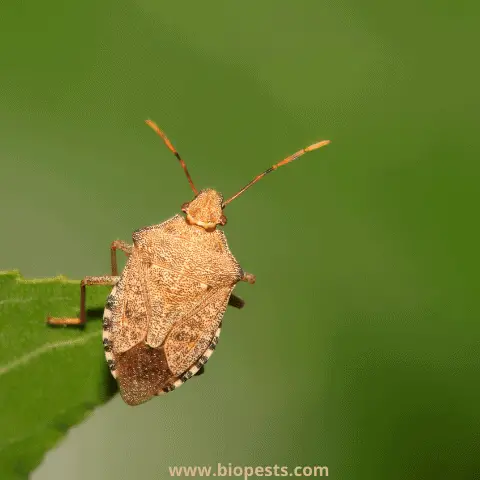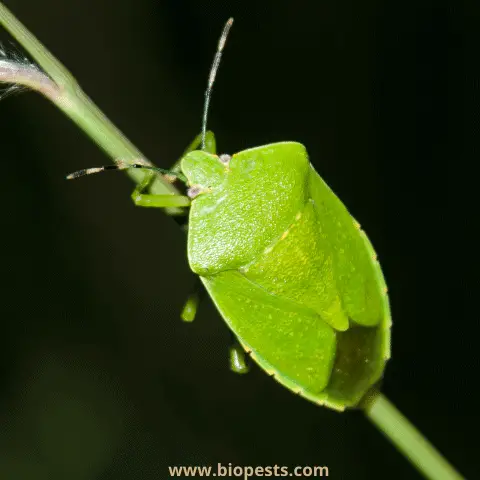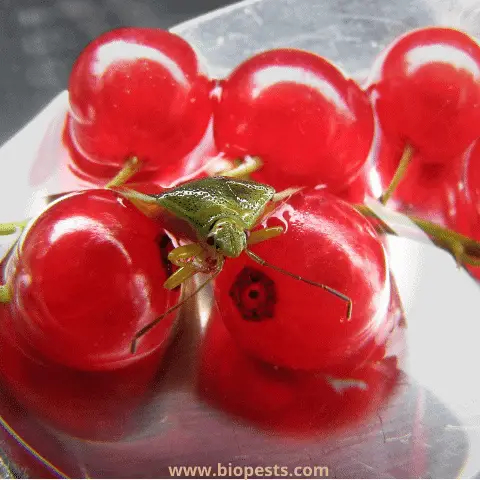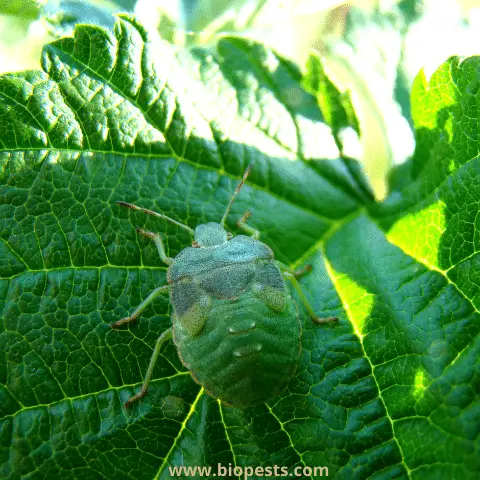Stink Bugs can be a massive problem for plant owners. These pests are stinky and can make your home smell like a skunk was let loose in it, which can be annoying to any homeowner. The Stink Bug can also become an unsightly infestation, even in homes. But can these smelly creatures hurt your houseplants?
Stink Bugs cause damage to houseplants as they bite into the plant to eat the sap. These bites can cause the plant to scar at the bite location. The lack of sap can cause dead spots to appear on the plant’s foliage. The plant can wilt and have deformed or stunted growth or even die due to the bite.
Why are Stink Bugs attracted to houses in the first place? How can you get rid of Stink Bugs that are in your home and on your houseplants? How can you prevent the Stink Bugs from returning in the future? Let us find out!
Will Stink Bugs Hurt Houseplants?
Pentatomidae, otherwise known as the Stink Bug, is a common household pest that lives in all corners of the globe. These pests get their name from the highly unpleasant odor they produce when they feel like they are being threatened.
Scientists believe that the Stink Bugs use this terrible odor as a defense against predators in the area. In the United States, there are hundreds of Stink Bug species that can destroy and damage your plants.

Houseplants are no exception to this either, as Stink Bugs will make their way into your home and go after your Houseplants too. Stink Bugs are plant feeders, meaning that they will damage your houseplants by eating them.
They will not only damage your plants when they are adults but when they are young too. The adult Stink Bugs are either green or brown, and some will have a brightly colored pattern on their backs over this base color.
This is an excellent way of identifying them as adults, and this is the stage where you need to get rid of them as fast as possible. If you see an adult Stink Bug in your home, then it’s not only there to eat your plants, but it is also looking for a place to lay its eggs on your houseplants.
The young Stink Bugs that hatch from these eggs are called Nymphs, and these are the ones that will do the most harm to your houseplants. They will eat your houseplants so that they can develop and grow into adult Stink Bugs, and they can easily kill your houseplant in the process.
The damage that a Stink Bug can do to your plants is due to the way they eat. Stink bugs will bite into the plant and feed on its sap. This can lead to small, dead patches on the foliage of your plant, and it can cause wilting, stunted, or even distorted growth of your affected plant. If there are enough pests on your houseplant, then they can even kill the infested plant.
What Attracts Stink Bugs To Your House?
Stink Bugs will be attracted to certain factors over others in your house. But many things will make your home more attractive to these stinky pests that you are not even aware of. Stink Bigs will actively seek out warm and cozy areas to wait out the winter and areas on plants that are warm and dark to lay their eggs.
Here is a list of locations in your home that may attract Stink Bugs and why they attract them:
- Holes or Crevices in the walls of your house are dark, warm, and undisturbed
- Higher areas: Stink Bugs prefer to congregate in the higher stories of a house instead of basements
- They can be tucked in curtain folds or behind hanging photos as these places do not get disturbed regularly
- In areas containing houseplants, you will find them on the plants, on the side of the plant pots closer to the wall.
As you can see, the plants you have in your house are not necessarily the things attracting the Stink Bugs to your home. But if you do have houseplants, it can cause the Stink Bugs to stay in your home and lay eggs on the underside of the plant’s leaves.

Most Stink Bugs will also release a pheromone into the air when they find a comfortable area to stay or a lovely plant to eat. This pheromone will attract more Stink Bugs to that location, easily leading to an infestation.
How To Rid Your Houseplants Of Stink Bugs
Stink Bugs can be an extremely irritating pest to deal with as they can breed fast and spread from houseplant to houseplant with ease as they do not discriminate, and they will eat almost every plant you have.
These shield-shaped stinky pests are difficult to get rid of as they can even release their nose-curling odor when they are dead, especially if you squish them. This can easily start stinking out of your home, and the smell can last for days.
Let us go through the methods you can use to get rid of Stink Bugs in your home. Just remember to clean up any dead bugs you see and throw them in the garbage before they become a problem.
Keep The Plant Clean
The best way to stop a Stink Bug infestation, to begin with, is to keep your houseplants and their soil and pots clean. You need to make sure your plant does not have any diseased or dying leaves that give off an odor that may attract the bugs into your home.
You need to keep the plant’s area and soil free of debris as these pests love to hide in decomposing places, like plant matter and wood mulch. It is a better idea to avoid using mulch or other materials in your houseplants pot and instead use fertilizer or liquid fertilizer that will seep into the soil and not decompose.
If you see that any part of your houseplant is beginning to look unhealthy and may start wilting and dying, then you need to remove this part as soon as you can. Checking the plant and cleaning it of dust and other debris will also disrupt your plant’s area with your movement.
As we mentioned earlier, Stink Bug will go and find an area of your home that is not disturbed regularly. So, you need to disrupt the plant’s location as much as possible, and keeping the plant clean will accomplish this.
Plant Companion Plants To Repel Stink Bugs
Suppose you do not have the time to thoroughly examine your plant regularly to clean off any dead or dying leaves or disrupt the plant’s location regularly. In that case, you can consider planting some companion plants with your houseplants that repel the Stink Bugs from your home.
This option is somewhat ironic as you can repel these stinky arthropods by planting smelly plants. These plants have a pleasant smell to us humans, but to the Stink Bug, they smell terrible.
Some examples of companion plants you can have in your house include:
- Catnip
- Garlic
- Thyme
- Lavender
- Basil
- Lemongrass
- Mint
- Rosemary
- Sage
- Allium
- Chrysanthemums
The great thing about most of these companion plants for your houseplants is that you can use most of them in your kitchen too. So, not only are you ridding your house and houseplants of Stink bugs, but you can make some delicious recipes, too.
Set A Trap For The Stink Bugs
You can make a Stink Bug trap to rid your home and your houseplants of these pests. An easy trap to make is to rig up a battery-powered light near your houseplant that is infested with Stink Bugs.

Once the light is up, place a bowl or a pan under the light and fill this container with soapy water. Leave this light on overnight, the Stink Bugs will be attracted to the light throughout the night, and when they fly into the light and hit it, they will fall into the container of soapy water.
This is where they will perish as they will drown in the water, and the soap in the water will help reduce the smell of the dead bus until you have the chance to throw them out in the morning.
If you do not want to set this trap up, some commercially available traps will release a pheromone that these stinky creatures find irresistible, attracting the bugs and trapping them. However, most gardeners argue that the effectiveness of these pheromone traps is negligible at best.
Use Organic Repellents And Pesticides For Stink Bugs
You can also use organic repellent and organic pesticides to help rid your home of Stink Bugs. You can, again, use the stinky versus stinky scenario we mentioned earlier, and you can mix a garlic spray to spray your houseplants with.
To make this organic repellent, you can chop up five or six fresh cloves of garlic and boil them in a pot of one gallon of water. Then let this water cool down and place it into a spray bottle. Spray your highly susceptible plants with this garlic water to repel the bugs.
Another excellent Stink Bug repellent is neem oil. You will also need to dilute the oil with water, and then using a spray bottle, thoroughly spray your plants. If your plants are coated with the oil, the bugs will not go near it as they do not like the smell or the taste of the neem oil.
You can find this oil at your local gardening store and then follow the instructions on the container to use this product safely and effectively.
You can use insecticidal soap against these bugs too. Although this soap is used primarily for soft-bodied creatures, many gardeners report success using it against Stink Bugs.
Use A Chemical Pesticide For Stink Bugs
Using a chemical-based pesticide to kill Stink Bugs on your houseplants should always be used as a last resort and should never be your go-to product. The reason for this is because using a chemical pesticide indoors can be dangerous.
Most chemical pesticides are also toxic to humans and are classified as likely carcinogenic to humans. You should also note that these products will kill the beneficial insects that live on your houseplant too.
So, you should only use these chemical products if you have a terrible infestation of Stink Bugs on your houseplants. You can find a chemical insecticide at your local gardening store. Just be sure to use the proper safety precautions like, wear gloves and a mask while applying the insecticide, opening all windows in your house, and placing the plant in an open door for a few hours.
Call A Professional To Exterminate The Stink Bugs
If you have a significant Stink Bug problem and you are unsure of how to deal with it yourself, then you can call a professional to come and inspect your home. Call a professional who will assess the problem in your house can give you a “game plan” on how to fix it.
They will recommend the best Stink Bug killing products for your needs, and they will show you how to use them safely. If you are in two minds about how to save your plants from Stink Bugs, call your local gardening services. They will advise you on what you are and are not allowed to use within the law of your state.
Prevent Stink Bugs From Entering Your House
The best method to protect your houseplants from Stink Bugs is to prevent them from entering your house in the first place. To help protect your houseplants, you need to inspect the interior and exterior of your home for any small cracks and cervices that the Stink Bug may be able to crawl through.
You need to seal these cracks with caulk or weatherstrip and ensure it is done correctly, so it will not break or crack again for a while. You will also need to examine your doors and windows to ensure no holes for Stink Bugs to get through.

You need to fix any holes in screen doors, and you need to cover any open vents to crawl spaces, attics, chimneys, and window air-conditioners. These are prime places for Stink Bugs to make their way into your home.
You can also plant repellent plants outside your home for another layer of protection, and you can spray areas like windows with diluted neem oil or garlic water spray to help repel the bugs from your home.
Conclusion
Stink Bugs are a massive pain for plant owners, as they can really damage plants and even kill the plants if the infestation is bad enough. Unfortunately, this does not exclude houseplants, as they are just as suspectable as outdoor plants to these smelly pests. Thankfully, there are some ways you can rid your home and plants of these pests; just ensure that you are safe when using any of these methods. Good luck ridding your houseplants of Stink Bugs! References
